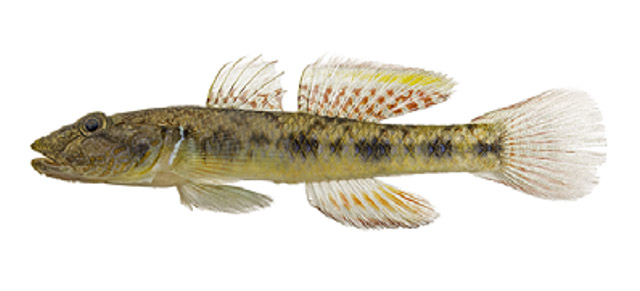Rhinogobius
similis
Gill,
1859
View all media / Upload your photos and videos
Expand all
Classification / Names
Teleostei (teleosts) > Gobiiformes (Gobies) >
Gobiidae (Gobies)
> Gobionellinae
Etymology: Rhinogobius: Greek, rhinos = nose + Latin, gobius = gudgeon (Ref. 45335).
More on author:
Gill.
Environment / milieu / depth range / climate zone / distribution range
Freshwater; benthopelagic; temperate.
Distribution
Size / Weight / Age
Max length: 10.0 cm TL male/unsexed (Ref. 2058); max length: 6.6 cm SL (female).
Short description
Dorsal spines (total): 7; Dorsal soft rays (total): 8; Anal spines: 1; Anal soft rays: 8; Vertebrae: 26. This species is distinguished from its congeners by the following combination of characters: D1 I,8; pectoral-fin rays 18-19; predorsal scales 8-12; longitudinal scales 29-31; vertebrae 11+15 = 26; predorsal squamation composed of large ctenoid scales, reaching anteriorly to near posterior margin of the eye; short transverse rows of sensory papillae 5-6 below eye; several short transverse rows of sensory papillae (a part of row c) between 2 longitudinal rows of sensory papillae on cheek; head with a dark brownish gray reticulation or reddish oblique lines except for its ventral surface; upper end of pectoral-fin base with a black spot, as large as pupil; midlateral body with a longitudinal series of alternating large and small black blotches; 2-4 irregular longitudinal rows of small skyblue spots on midlateral body when alive (Ref. 104791).
Main reference
Suzuki, T., K. Shibukawa, H. Senou and I.-S. Chen 2015 Redescription of Rhinogobius similis Gill 1859 (Gobiidae: Gobionellinae), the type species of the genus Rhinogobius Gill 1859, with designation of the neotype. Ichthyol. Res. 62(3):1-14. (Ref. 104791)
IUCN Red List Status (Ref. 125652)
CITES (Ref. 131153)
Not Evaluated
CMS (Ref. 116361)
Not Evaluated
Threat to humans
Potential pest (Ref. 13364)
More information
- Countries
- FAO areas
- Ecosystems
- Occurrences
- Introductions
- Stocks
- Ecology
- Diet
- Food items
- Food consumption
- Ration
- Common names
- Synonyms
- Metabolism
- Predators
- Ecotoxicology
- Reproduction
- Maturity
- Spawning
- Spawning aggregation
- Fecundity
- Eggs
- Egg development
- Age/Size
- Growth
- Length-weight
- Length-length
- Length-frequencies
- Morphometrics
- Morphology
- Larvae
- Larval dynamics
- Recruitment
- Abundance
- References
- Aquaculture
- Aquaculture profile
- Strains
- Genetics
- Allele frequencies
- Heritability
- Diseases
- Processing
- Mass conversion
- Vision
- Pictures
- Stamps, Coins Misc.
- Sounds
- Ciguatera
- Speed
- Swim. type
- Gill area
- Otoliths
- Brains
Estimates based on models
Phylogenetic diversity index (Ref. 82804): PD50 = 0.5 [Uniqueness, from 0.5 = low to 2.0 = high].
Bayesian length-weight: a=0.00724 (0.00338 - 0.01553), b=3.05 (2.87 - 3.23), in cm total length, based on LWR estimates for this (Sub)family-body shape (Ref. 93245).
Trophic level (Ref. 69278): 3.3 ±0.4 se; Based on size and trophs of closest relatives.
Resilience (Ref. 120179): High, minimum population doubling time less than 15 months (Preliminary K or Fecundity.).
Fishing vulnerability (Ref. 59153): Low vulnerability (10 of 100).
Nutrients (Ref. 124155): Calcium = 0 [0, 0] mg/100g; Iron = 0 [0, 0] mg/100g; Protein = 0 [0, 0] %; Omega3 = 0 [0, 0] g/100g; Selenium = 0 [0, 0] μg/100g; VitaminA = 0 [0, 0] μg/100g; Zinc = 0 [0, 0] mg/100g (wet weight);


